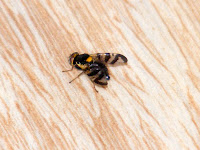To identify flies to family level use a simple wing venation key such as A Key to the Families of British Diptera, an AIDGAP by D. Unwin, published by the FSC and available as a free download (scroll down to the titles list) or a more detailed key which includes many physical characters such as The European Families of the Diptera by P. Oosterbroek. The expert dipterists on the DipteraInfo forum are also very happy to identify, often to species level, from good photographs.
Scientific Name: Rhagoletis cerasi (Tephritidae).
English Name: Common Cherry Fruit Fly.
French Name: La Mouche de la cerise.
 5 Key Characters:
5 Key Characters:
Habitat: There are two races of R. cerasi, which may, after further study, turn out to be two different species. One is a pest of Lonicera spp Honeysuckles, the other is a pest of Prunus spp (principally Cherries). They are most often encountered on or around the host plants. The larvae feed on the fruit of the host plants, rendering commercial cherry crops worthless if infested.
Flight Period: May-June-July.
Status: Common.
Further Information:
Cherries are in, a post on our daily blog Days on the Claise, with details of the Common Cherry Fly life cycle.
Photographed by Loire Valley Nature:
Photographs are numbered from left to right, top to bottom. All photos will enlarge in a new window if you click on them. 1 - 3 in our kitchen/pantry, May.
English Name: Common Cherry Fruit Fly.
French Name: La Mouche de la cerise.
 5 Key Characters:
5 Key Characters:- patterned wings.
- black body.
- yellow scutellum (the crescent shaped bit of the thorax, just before the abdomen)
- waves its wings as it walks.
- green eyes.
Habitat: There are two races of R. cerasi, which may, after further study, turn out to be two different species. One is a pest of Lonicera spp Honeysuckles, the other is a pest of Prunus spp (principally Cherries). They are most often encountered on or around the host plants. The larvae feed on the fruit of the host plants, rendering commercial cherry crops worthless if infested.
Flight Period: May-June-July.
Status: Common.
Further Information:
Cherries are in, a post on our daily blog Days on the Claise, with details of the Common Cherry Fly life cycle.
Photographed by Loire Valley Nature:
Photographs are numbered from left to right, top to bottom. All photos will enlarge in a new window if you click on them. 1 - 3 in our kitchen/pantry, May.









No comments:
Post a Comment